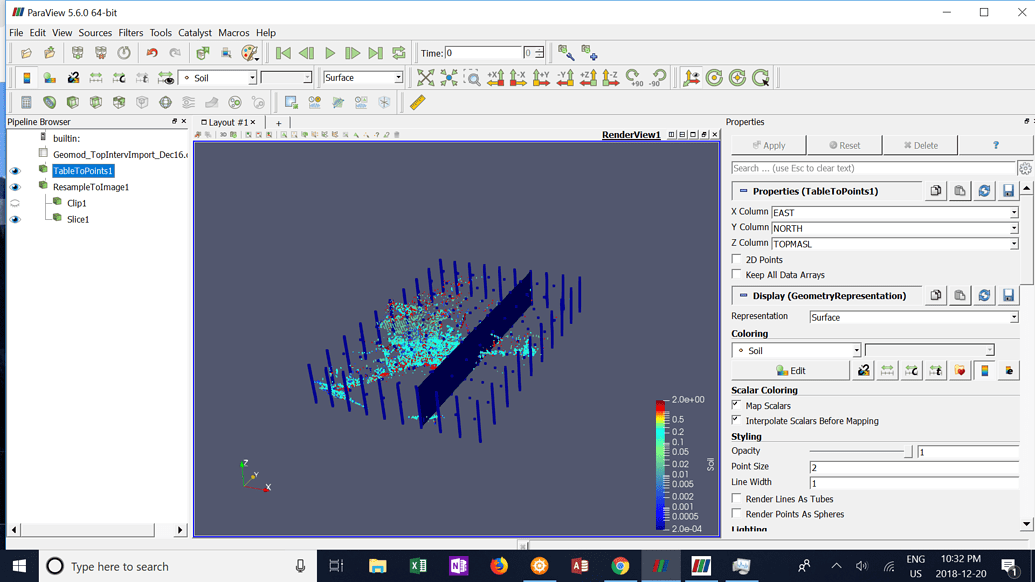

- #PARAVIEW 3D PDF PDF#
- #PARAVIEW 3D PDF GENERATOR#
- #PARAVIEW 3D PDF SOFTWARE#
- #PARAVIEW 3D PDF LICENSE#
For spot welds, the joint locations are filled with material and may be smaller than for bolts. When considering riveted or bolted joints, the local part geometry at the joint location consists of holes that are surrounded by material. The presented method models the force transfer at a joint location not only by using single spring elements but accounts for the size and type of the joints. The underlying coupling equations allow for connecting dissimilar meshes and avoid the need for remeshing when joint locations change. Therein, the joint locations are not discrete and predefined, but continuously movable. This paper provides a method for the simultaneous topology optimization of parts and their corresponding joint locations in an assembly. A density filtering algorithm based on the Helmholtz formulation is used. The problem considered is compliance minimization / stiffness maximization, considering the examples of multi-component structures recurrent in the literature. The topological optimization method used is based on SIMP interpolation – Solid Isotropic Material with Penalisation.
#PARAVIEW 3D PDF SOFTWARE#
Paraview software is used to visualize the results, which is an open source cross-platform data visualization and analysis application. For the conversion/reading of the generated models, the Meshio package is used.
#PARAVIEW 3D PDF GENERATOR#
To generate the meshes, the Gmsh software is used, which is an open source finite element mesh generator with an integrated CAD engine and post-processor. For the optimization process, Ipopt is used, which is a large-scale nonlinear optimization software designed to find solutions of mathematical optimization problems. In order to allow the automated numerical solution of Partial Differential Equations (PDEs) and to perform a sensitivity analysis, the FEniCS and Dolfin Adjoint software are used, which are open source code. The implementation of structural topological optimization in multi-component elements in this work involves four main components: multi-component meshing, numerical analysis using the Finite Element Method (FEM), sensitivity analysis by an adjoint method and an optimization solver. Currently, there are few approaches to the analysis of multi-component structures and they are still made using commercial software. Research and techniques that use structural topological optimization, mostly, deal with continuous structural elements with a single domain, or single component, and it is observed that the real structures are complex and multi-component. Structural topological optimization is widely used by several researches and projects in the process of improving structural elements. Terminate ( ) print ( "Done.This work analyzes the implementation of a discrete method of structural topology optimization in 3D or Three Dimensional multi-component elements using the open-source FEniCS tools and other complementary tools such as Dolfin Adjoint, Gmsh, meshio, Ipopt and Paraview. Save (output_path + "dice_u3d.pdf", SDFDoc. Put ( "N", normal_ap_stream ) def main ( ) :
#PARAVIEW 3D PDF PDF#
PushBackNumber ( 0 ) # Create annotation appearance stream, a thumbnail which is used during printing or # in PDF processors that do not understand 3D data. PutNumber ( "CO", 27.5 ) # A 12-element 3D transformation matrix that specifies a position and orientation # of the camera in world coordinates. Put ( "3DD", u3d_data_dict ) # Set the initial view of the 3D artwork that should be used when the annotation is activated.

CreateIndirectStream (u3d_reader, FlateEncode (Filter ( ) ) ) U3d_file = MappedFile (input_path + "dice.u3d" ) PutName ( "A", "PO" ) # Embed U3D Streams (3D Model/Artwork). Other options are: PV (page view) and XA (explicit) activation.Īctivation_dict_3D. PutDict ( "3DA" ) # Set the annotation so that it is activated as soon as the page containing the # annotation is opened. PushBack (link_3D ) # The 3DA entry is an activation dictionary (see Table 9.34 in the PDF Reference Manual) # that determines how the state of the annotation and its associated artwork can change.Īctivation_dict_3D = link_3D. PutName ( "Subtype", "3D" ) # Annotation location on the page PDF 1.6 introduces the capability # for collections of three-dimensional objects, such as those used by CAD software, # to be embedded in PDF files. Output_path = "././TestFiles/Output/" def Create3DAnnotation (doc, annots ) : # - # Create a 3D annotation based on U3D content. append ( "././LicenseKey/PYTHON" ) from LicenseKey import * # Relative path to the folder containing the test files. addsitedir ( "./././PDFNetC/Lib" ) import sys
#PARAVIEW 3D PDF LICENSE#
# Consult LICENSE.txt regarding license information. #- # Copyright (c) 2001-2022 by PDFTron Systems Inc.


 0 kommentar(er)
0 kommentar(er)
